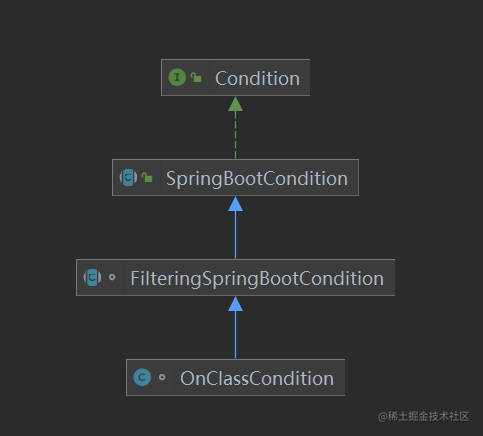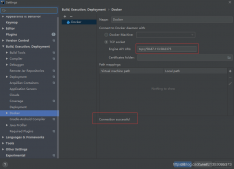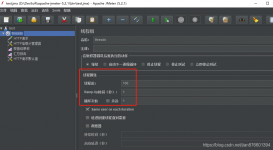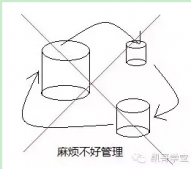@ConditionalOnClass的底层源码实现
在SpringBoot中,支持了很多种条件注解,@ConditionalOnClass注解就是其中之一,而且及其重要,它主要是用来判断该注解所指定的某个类或某些类,是否在ClassPath中存在,如果存在则符合条件,如果不存在则不符合。
|
1
2
3
4
5
6
7
8
|
@Target({ ElementType.TYPE, ElementType.METHOD })@Retention(RetentionPolicy.RUNTIME)@Documented@Conditional(OnClassCondition.class)public @interface ConditionalOnClass { Class<?>[] value() default {}; String[] name() default {};} |
这是该注解的源码,可以通过value和name来指定要判断的类,而真正执行判断的逻辑在OnClassCondition类中。
- OnClassCondition类继承了FilteringSpringBootCondition类
- FilteringSpringBootCondition类又继承了SpringBootCondition类
- SpringBootCondition类实现了Condition接口

Spring在解析条件注解时,就会调用Condition接口的matches()方法,在上面的类继承关系中,SpringBootCondition类实现了matches()方法,所以会先被调用。
ConditionOutcome对象
在matches()方法中,会调用getMatchOutcome()方法,并得到ConditionOutcome对象,ConditionOutcome对象就表示条件判断的结果。
|
1
2
3
4
5
|
public class ConditionOutcome { // 表示条件是否匹配 private final boolean match; // ...} |
getMatchOutcome()方法在SpringBootCondition类中是一个抽象方法,在子类OnClassCondition类中才真正实现了getMatchOutcome()方法,并真正会进行条件判断。
所以核心就是这个getMatchOutcome()方法,在这个方法中会先获取@ConditionalOnClass注解的value和name属性的值,这些值就是待判断的类名集合。
|
1
2
|
// 调用getCandidates方法List<String> onClasses = getCandidates(metadata, ConditionalOnClass.class); |
|
1
2
3
4
5
6
7
8
9
10
11
|
private List<String> getCandidates(AnnotatedTypeMetadata metadata, Class<?> annotationType) { MultiValueMap<String, Object> attributes = metadata.getAllAnnotationAttributes(annotationType.getName(), true); if (attributes == null) { return null; } List<String> candidates = new ArrayList<>(); addAll(candidates, attributes.get("value")); addAll(candidates, attributes.get("name")); return candidates;} |
ClassNameFilter.MISSING判断某类是否不存在
接下来就会逐个判断类名集合中的每个类名,判断逻辑为:利用ClassNameFilter.MISSING来判断某类是否不存在?
|
1
|
List<String> missing = filter(onClasses, ClassNameFilter.MISSING, classLoader); |
|
1
2
3
4
5
6
7
8
9
10
11
12
|
protected final List<String> filter(Collection<String> classNames, ClassNameFilter classNameFilter, ClassLoader classLoader) { if (CollectionUtils.isEmpty(classNames)) { return Collections.emptyList(); } List<String> matches = new ArrayList<>(classNames.size()); for (String candidate : classNames) { if (classNameFilter.matches(candidate, classLoader)) { matches.add(candidate); } } return matches;} |
ClassNameFilter.MISSING就是利用ClassLoader来加载类,如果加载到了表示类存在,没加载到就表示不存在。
|
1
2
3
4
5
6
7
8
9
10
11
12
13
14
15
16
17
18
19
20
21
22
|
protected enum ClassNameFilter { // ... MISSING { @Override public boolean matches(String className, ClassLoader classLoader) { // 是否不存在 return !isPresent(className, classLoader); } }; static boolean isPresent(String className, ClassLoader classLoader) { if (classLoader == null) { classLoader = ClassUtils.getDefaultClassLoader(); } try { resolve(className, classLoader); return true; } catch (Throwable ex) { return false; } }} |
|
1
2
3
4
5
6
|
protected static Class<?> resolve(String className, ClassLoader classLoader) throws ClassNotFoundException { if (classLoader != null) { return Class.forName(className, false, classLoader); } return Class.forName(className);} |
判断完之后,只要missing集合不为空,那就表示待判断的类中有类不存在,那就返回条件不匹配的ConditionOutcome对象,否则就返回条件匹配的ConditionOutcome对象。
这就是@ConditionalOnClass注解的核心源码流程,期待你的点赞哦。
以上就是SpringBoot注解@ConditionalOnClass底层源码实现的详细内容,更多关于SpringBoot ConditionalOnClass的资料请关注服务器之家其它相关文章!
原文链接:https://juejin.cn/post/7106028610951053326
















